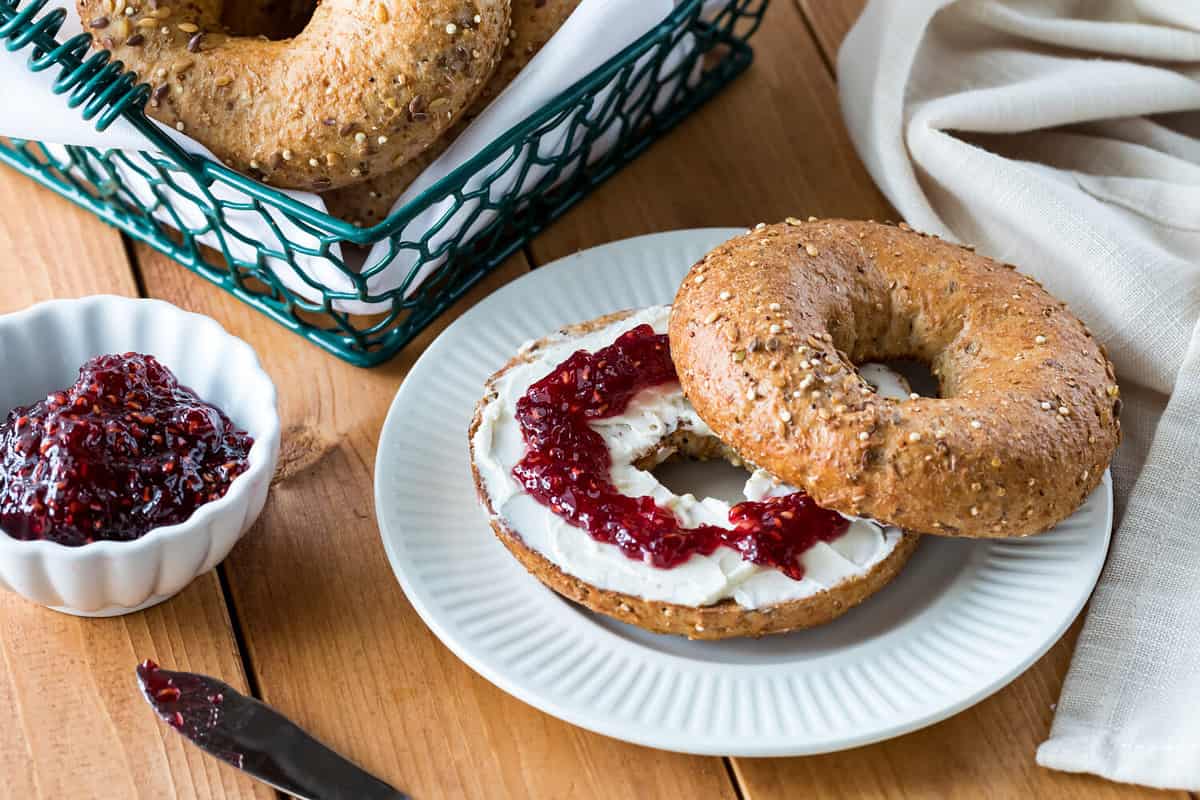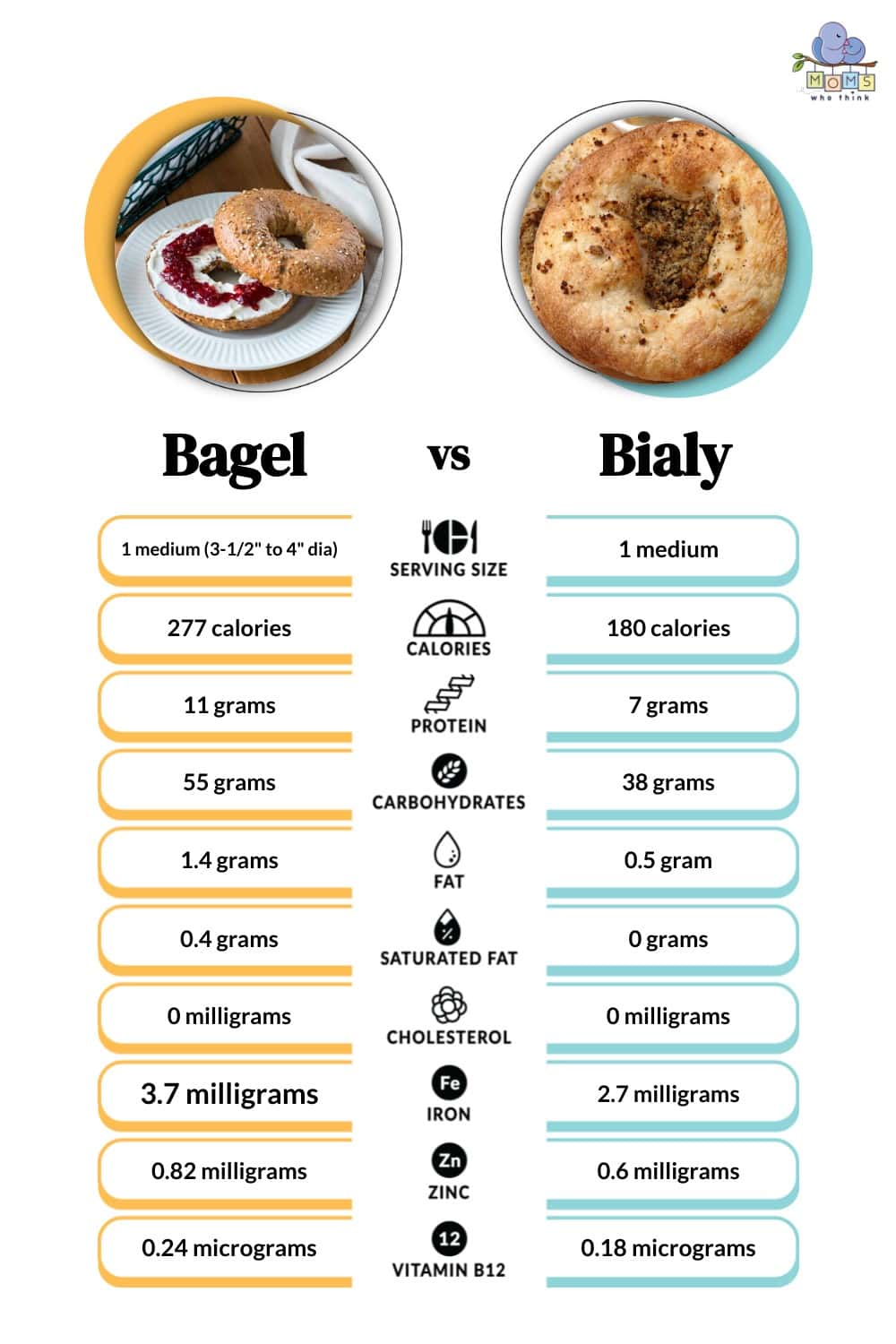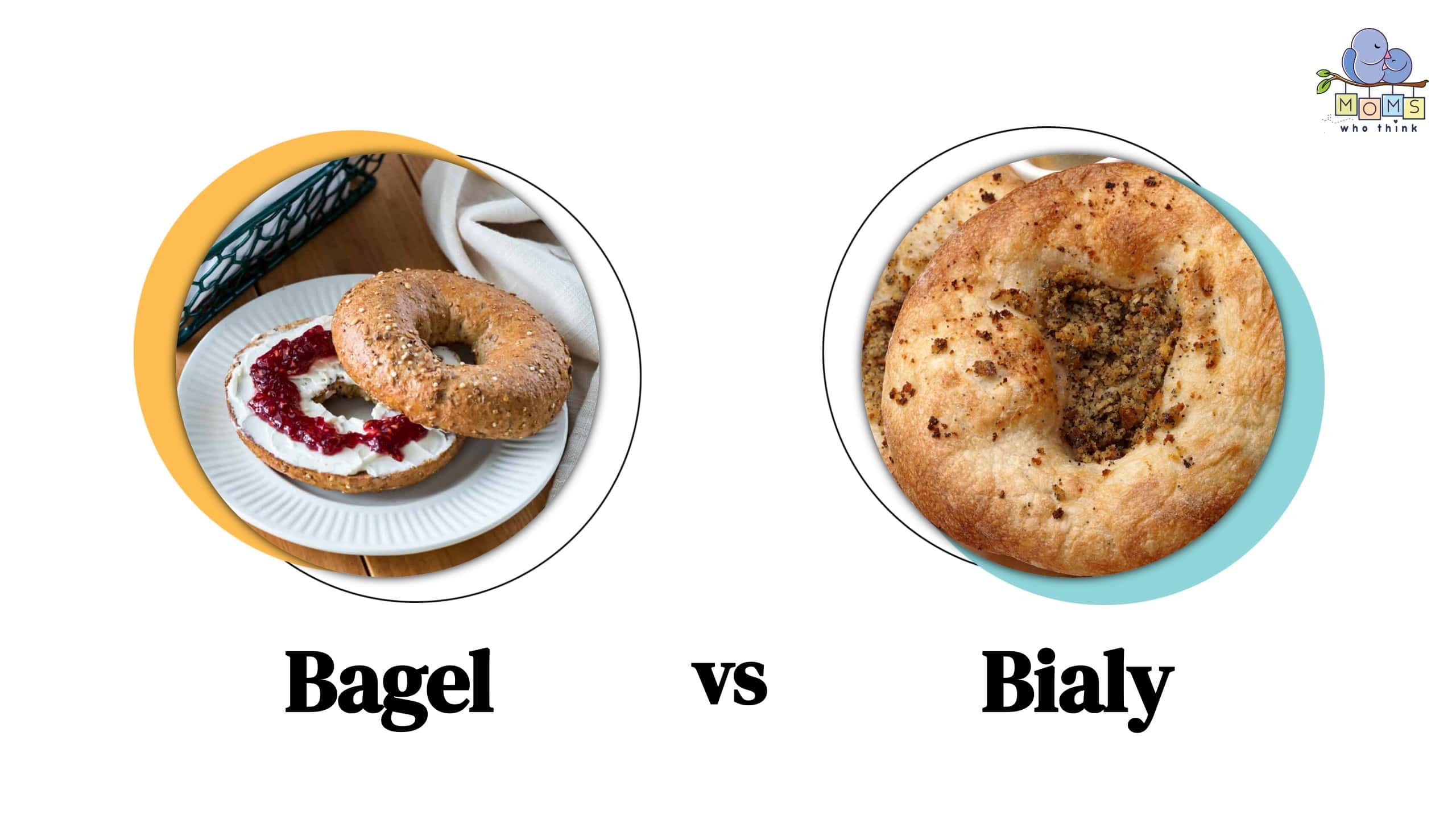If you’re visiting the Big Apple, you might stumble across a delicious, onion-filled roll that looks strikingly similar to a bagel. This tasty roll is known as a bialy, but if you don’t live in New York, it’s possible you’ve never heard of this type of bread. Whether you’re new to the world of bialys or you’ve tried them before, you might be wondering: what’s a bialy and how is it different from a bagel?
The main difference between a bialy and a bagel is the way you make them. While bagels are made by boiling the dough and then baking it, bialys are only baked. The signature flavor of a bialy is also onion while bagels can come in a wide range of flavors and varieties.
Maybe you’ve never heard of a bialy but it’s starting to sound delicious to you. Keep reading to find out more about the difference between bialys vs. bagels.

Even though a bialy may look similar to a bagel, it's actually a different type of bread.
©Toasted Pictures/Shutterstock.com
Bagel vs. Bialy: What Is the Difference?
While a bialy does look similar to a bagel, they’re not actually the same thing. In fact, bialy enthusiasts would be the first to tell you that this type of Jewish bread is much different in a bagel with a completely different flavor and texture.
The main difference between a bialy and a bagel is the process of making them. When you make bagels, you boil the dough and then bake it, but you only bake the dough for a bialy. This leads to a different texture and outer appearance. Due to the boiling process, bagels are more shiny while bialys have a matte appearance, but bialys are also softer in texture.
At first glance, it might seem like a bialy has a hole in the center like a bagel, but it’s actually just a depression or indent, not a hole that goes all the way through. Typically, you add cooked onions to the depression for a filling.
Both bagels and bialys are excellent breakfast or brunch foods, but you can purchase bagels in a wide variety of flavors. Also, it's common to top bagels with cream cheese, although you can spread butter or jam on them as well. Likewise, you can toast a bialy and top it with cream cheese like you would a bagel, but traditionally, you would eat them fresh out of the oven or with butter.
Main Differences Between a Bagel vs. Bialy
You really can’t go wrong with any type of breakfast roll or bread, and both bagels and bialys are an excellent choice. The main differences between them are:
- You boil bagels and bake bialys
One of the main differences between bagels and bialys is the way you make them. While a bagel is boiled before it’s baked, a bialy is only cooked in the oven. The difference in the cooking process leads to a different appearance and texture. - Bagels come in a wide variety of flavors
Bagels can come in any flavor from poppyseed to cinnamon raisin. Bialys specifically come with onions in the middle and while there are some deviations with the addition of poppyseeds or other seasonings, you won’t find numerous flavors of bialys like you find with bagels. - Bialys are originally from Poland and are sold mainly in New York
Bagels are pretty easy to find whether you’re looking in the grocery store, a bakery, or even a bagel shop, but bialys are not quite as easy to find. They’re mostly popular in New York City, and even there you have to search a bit to find an authentic bialy.
Nutritional Value of a Bagel vs. Bialy

What Is a Bialy?
Move over bagels, there’s a new breakfast roll in town. Even though bialys aren’t exactly new, they’re not as popular or well-known as bagels. Many people who see bialys think that they’re just a specific type of bagel, but there’s actually many differences between them.
A bialy is a type of breakfast roll with a slight indent in the center. To create the authentic flavor of a bialy, you add sautéed onions to the center and bialys sometimes contain poppyseeds as well. Unlike bagels, a bialy doesn’t have a hole in the center. Instead, it has a depression or intent where you place the cooked onions. Also, you bake the bialy dough instead of boiling the dough first like you would with a bagel.
The cooking process does impact the appearance of these breads since the outside of a bialy is matte, unlike the shiny appearance of a bagel. The texture of a bialy is also softer and lighter than a bagel. These tasty rolls originated in Poland and were brought to the United States by Jewish immigrants, which is why they’re so popular in New York.

Bialys are best when you eat them fresh, straight out of the oven.
©Elzbieta Sekowska/Shutterstock.com
How Do You Eat a Bialy?
Since we’ve determined that a bialy is not the same as a bagel, you might wonder how you should eat them. They’re best eaten fresh out of the oven although unless you’re making them yourself, it may be hard to find a place where you can purchase fresh bialys, depending on where you live.
You certainly can add cream cheese or other toppings, but traditionally, you eat them plain or with butter. Even though they’re delicious as is, you can add cream cheese, butter, or other toppings if you choose. You can also slice the roll and use it for a breakfast sandwich.
What Is a Bagel?
A bagel is a type of bread roll that’s generally seen as a breakfast food, although you can enjoy a bagel any time of day. Like bialys, bagels also originated in Poland and were brought over to the United States by Jewish immigrants.
However, unlike bialys, bagels caught on in mainstream food culture and are now large companies mass-produce bagels to sell in most grocery stores. However, those who have had a fresh-baked, authentic New York City bagel would say that the bagels you find in most stores don't compare.
While there are many arguments online about where you can buy the best bagels and how you should eat them, there are many varieties of bagels out there. Interestingly enough, the bagels you see today are bigger than the original bagels. One theory about the reason behind this is that many restaurants use bagels for breakfast sandwiches now, which requires a larger surface area.
Nowadays, you can find bagels almost anywhere from your favorite bakery to your local grocery store. The quality of the bagels will vary depending on where you get them from. One of the traditional ways to eat this breakfast food is enjoying a bagel with cream cheese and lox, or smoked salmon.
However, many people now eat bagels with cream cheese, butter, jam, peanut butter, or even use them for a delicious breakfast sandwich.
Where Can You Find a Bialy?
If you’re wondering why bialys can mainly exist in New York City, it’s because Jewish immigrants brought them to New York. After the recipe made its way to the United States, bialys started to catch on in local bakeries, but never spread far outside of the state. This is partly because bialys taste best fresh, so it’s not as common for bakeries to ship them or even mass produce them.
If you’re looking for a bialy outside of New York, you might struggle to find one. More often than not, you’ll find authentic bialys in Jewish communities. For example, there are some places in Florida that sell them, such as Flakowitz, a Jewish bakery in Palm Beach County. Even if you can’t find one near you, you can always find a recipe online and try to make your own!
Bagel vs. Bialy: Which Is Better?
You can’t go wrong with any type of fresh, delicious bread. Even though bagels and bialys have a lot in common, they’re actually a different type of bread and have many different qualities. The main difference between them is that you bake bialy dough and boil bagel dough. Also, all bialys contain cooked onions while you buy bagels in a variety of flavors.
Both these rolls are a delicious treat in the morning or any time of day. Some might prefer one or the other, but it depends on your preferences. If you ever have the chance to try a bialy from an authentic Jewish bakery, order one (or two!) so you can experience the joy of a fresh-baked bialy.
